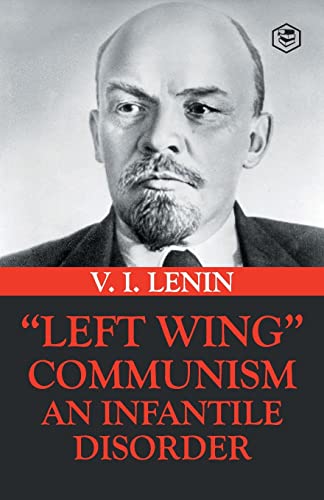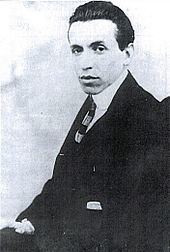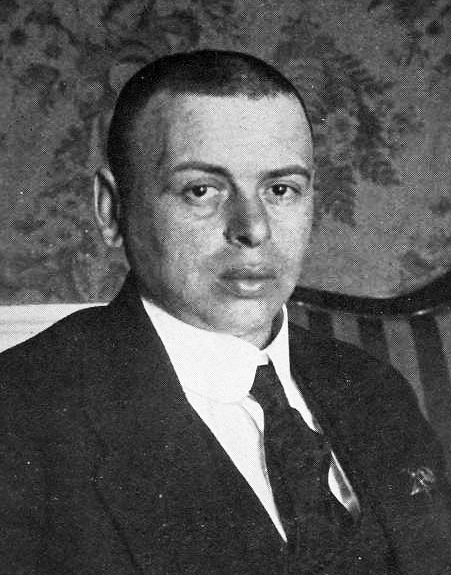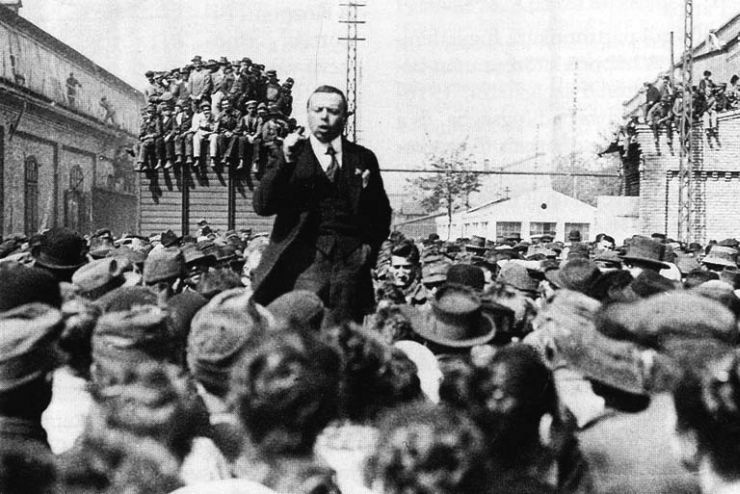Cain O’Mahony continues his three-part historical analysis of the 1919 Hungarian Revolution. [Part I can be read here and Part III here] . [Main photo shows Bela Kun addressing a rally.]
The leader of the Hungarian Bolsheviks was Béla Kun (1886-1938). A former Social Democrat journalist, he was among nearly a million Austro-Hungarian troops languishing in Russian prisoner-of-war (PoW) camps when the 1917 revolution broke out. Like thousands of Hungarian PoWs, Kun fully supported the internationalist revolution and joined the Bolshevik party, soon rising through its ranks.
His entry into Bolshevik politics came during a major faction fight over the proposed peace treaty of Brest-Litovsk, which would secure peace with Germany but see revolutionary Russia concede over a million square miles of territory.
Lenin’s position was that the treaty had to be accepted, as they vitally needed to consolidate the revolution, now under threat of a counter-revolution led by General Kornilov and his ‘White’ Army, which could only be strengthened if they still had to fight a ‘second front’ with the German army.
Germany had to be taken out of the picture if the fledgling Soviet Russia was to survive, even if it meant conceding territory: Lenin’s slogan was “losing space to save time.” He argued that the loss of territory would be temporary, because his perspective was that with the industrial powerhouse of the USA entering the war – along with a million fresh troops – Germany’s days were numbered.

Bukharin, representing the Left Communist faction, argued that the treaty should be rejected and the war continued, but this time under the red flag, and turned into a revolutionary war, just as the French revolution had done 130 years earlier, exporting and imposing their ideas across Europe. Bukharin won the support of Bela Kun and his Hungarian cohort to this aim, as well as new recruits to his Left Communist faction.
Lenin won the day, with the majority of Bolsheviks agreeing that the demand for peace (alongside ‘bread and land’) had been a cornerstone of mass support for the revolution, and there would be little enthusiasm for a continuation of the war, under whatever flag. Yes, the workers and peasants would fight to defend the gains of the revolution from internal and external reaction, but not the wild adventure of a new continental war.
Left Communists
It was Lenin’s first major clash with the Left Communists, and he was beginning to see in them a mechanical, unscientific approach to the class struggle. It would prompt him to pen his famous pamphlet two years later, Left Wing Communism: an Infantile Disorder, especially after the coming debacle in Hungary.
In it he wrote: “…those who try to deduce the tactics of the revolutionary proletariat from principles such as ‘the Communist Party must keep its doctrine pure… its mission is to the lead the way, without stopping or turning, by the direct road to the communist revolution’ – will inevitably fall into error.”
The Left Communists were indeed advocates of the ‘direct road’, with a total disregard for tactics in the face of the balance of class forces, which would end in disaster when Bela Kun attempted to implement it in revolutionary Hungary.
Bela Kun and his followers arrived in Budapest after the Aster Revolution in November 1918. They formed the ‘Kommunistak Magyavorszagi Partja’ (KMP) – correctly called the ‘Party of Communists from Hungary’ rather than the ‘Hungarian Communist Party’, as very few of the membership were ethnic Hungarians. They wished to demonstrate their internationalism and that Bolshevism was for all workers, regardless of what ‘class of citizen’ the former Hapsburg Empire had deemed them (see Part I).
They had an uphill struggle to climb. Kun did rapidly build the new KMP from scratch to 30,000 members, but this was still a flea compared to the 770,000 strong SDP with its massive base in their trade unions. But the early signs were favourable, with the SDP’s youth wing – the Young Workers’ League – going over to the KMP effectively en masse, as did most of the rank and file of the SDP in the second city of Szeged.

Later – commissar in the Hungarian Soviet Republic
This small mass influx would bring problems for the future though, because in the rush to put ‘numbers on the board’ to impress the comrades in Moscow, Kun was taking all-comers, even though many did not have a full grasp of Marxism. Tibor Szamuely also brought his Anarchist Tendency into the KMP with only the most cursory glance at the Marxist method and programme of the Bolsheviks, which only emboldened the ultra-leftism in the new KMP.
Bela Kun’s short-cut
Kun’s impatience was soon on show. Rather than ‘patiently explain’ and work amongst the mass ranks of the SDP-dominated labour movement, Kun saw a short cut. In Russia, had not the Bolsheviks galvanised the masses in August 1917 when they halted the advance of Kornilov’s White Army, leaving the Bolsheviks as being seen as the ‘saviours of the revolution’ in the eyes of the people? Kun would simply repeat the tactic here – even though no Hungarian ‘White Army’ existed at this stage.
In the pages of the KMP press they launched a campaign against a non-existent reactionary coup threat, in turn accusing the Karolyi government and the SDP of refusing to do anything about it. With this as a justification, on 20 February 1919, the KMP attempted to occupy the offices of the SDP’s main daily newspaper, the People’s Word, which ended with Szamuely’s anarchist ‘self-defence’ groups battling with police, leaving several dead.
Karolyi had become increasingly anti-Bolshevik, and seized the opportunity to smash the KMP. Kun and 67 other KMP leaders were arrested, their newspaper banned, and KMP offices across the country raided. The ultra-left stunt left the fledgling movement beheaded.
Two events came to their rescue, however. Firstly, initially the labour movement was confused about Kun’s actions and his attack on their traditional organisation. However, in a process similar to that which happened in Dublin, in 1916, after the failed Easter Rebellion, the initial rejection of the KMP’s tactics turned to anger when news leaked out that the KMP leaders were being beaten and tortured by police, while Kun himself was nearly beaten to death. The rumours on the street were that Kun had actually been murdered – he was seen as the ‘official representative of the Russian Revolution’ and the attack on Kun was seen as an attack on the revolution itself.
Such was the outrage that the Karolyi government backed off and gave orders that while in jail, Kun could carry out whatever political activities he wished to. He and the other KMP leaders began meeting with centrists and left-wing Social Democrats, at times meeting up to 400 people a day. The SDP visitors wanted Kun to join them in forming a government.
Then, while Kun was holding court in prison, a new crisis rocked the country. The victorious but belligerent Allies had already given a free hand to their new proxies of Romania, Czechoslovakia and Serbia to occupy Hungarian territory. But a further hammer blow came when the Allies demanded, on 20 March, that Hungary evacuate Debrecen and Mako and hand them over to their neighbours.
‘Government of the proletariat’
Any hopes of survival by the Hungarian bourgeoisie finally evaporated. Such was their desperation that they felt – along with many in the SDP – that by putting Kun at the head of the government, the Russian Red Army could come to Hungary’s aid. Imperialism had failed them, Karolyi’s bourgeois revolution had failed them, perhaps the Bolsheviks were their only saviours, at least to alleviate the immediate threat? The ‘bourgeois revolution’ had been still born; they had run out of options and effectively gave up. Their representative, Karolyi, resigned and in the resultant vacuum, a statement was issued (supposedly in Karolyi’s name) that he had given up his powers to a ‘new government of the proletariat’.
Lenin often remarked that ultra-leftism and opportunism were two sides of the same coin. Kun grabbed the situation in the most opportunistic way. On 21 March, he merged the smaller KMP into the mass SDP to form the Hungarian Socialist Party, and they declared that Hungary was now the ‘Republic of Workers Councils ’ (for simplicity, I shall refer to it as the Soviet Republic).

This was the gravest of errors. He should have forced the Social Democrats to take power and insisted on the separateness of his growing Communist Party. The task of Communists, by working alongside the masses, was to show how the reforms promised by the SDP could only be given any real meaning by overthrowing capitalism itself, whilst placing demands on the Social Democrats and exposing them in the eyes of the masses, when the SDP did not – or could not – deliver, because of the confines of the capitalist system they had imprisoned themselves in. In this way, the KMP would break the reformist hold of the SDP over the workers and peasants, and bring the masses behind the flag of Bolshevism. That had been the method in Russia.
Instead, Kun dissolved the Communists into the SDP, to the extent that of the new government’s 13 top ministers, only four were Communists. It was a ‘half-way house’ revolutionary government. This breaking of the political demarcation lines only reinforced the masses’ illusions in reformism, or left it confused as to what exactly Bolshevism really was. It also left the way open for the right-wing Social Democrats to stab the Soviet Republic in the back, when the political situation shifted in their favour.
Lenin had been concerned that the youthful Hungarians would make mistakes, and despite all the demands on Moscow at the height of the Russian Civil War, as the Bolshevik regime fought for survival, he had been keeping in regular radio and telegraph contact with Kun.
It was becoming very clear that Kun was lying to Lenin about the real objective conditions in Hungary and the role the KMP was playing . Kun down-played the extent, support and role of the workers councils – the real revolutionary force in Hungary – to justify his new deal with the Social Democrats.
Lenin furious
Lenin was beginning to have his suspicions, and when he eventually found out about Kun’s Faustian deal with the SDP, he was furious. As historian Andras B Gollner, author of The Forgotten Revolution, put it:
“Lenin could not believe his ears, when he heard the news that Béla Kun dissolved his party into the apparatus of the Bolsheviks’ mortal enemy – the Hungarian Social Democratic Party – on the night of March 20th and gave up the leading role of the Hungarian Communist Party on the path to Socialism. He read the draft constitution of the (Budapest) Commune … and considered it a sick joke. He was also fully aware of the fact that Béla Kun was lying to him in his daily telegraphs, that proclaimed that there were no workers’ councils in Hungary and he (Béla) was leading the Social Democratic Party by the nose. One can say a lot of things about Vladimir Ilyich Lenin. The one thing he was not, is a fool” (Gollner, interviewed in the Hungarian Free Press, 16.01.22.).
This was not the seizing of power with mass support for a socialist programme. As Gollner puts it:
“No shots rang out in the streets of Budapest on March 21, 1919, there was no rushing of Parliament by an angry mob, or by a squadron of rebellious soldiers… The dictatorship of the proletariat came to Budapest on little cats’ feet…” ( Hungarian Free Press, 16.01. 2022).
The casual transition demonstrated the total capitulation of the Hungarian ruling class and their echoes in the SDP. As Trotsky would later write:
“It must not be forgotten that these politicians (Kun & Co.) did not have to conquer power; it was simply thrown at their feet by a bourgeoisie that had landed in a blind alley. Having assumed power without struggle, the Hungarian leaders demonstrated that they were not big enough to keep it. Their policy was a chain of errors “ (The US Militant, New York, August 15, 1929).
Bela Kun’s ’chain of errors’ began almost immediately. [Read Part One here ]



